A Comparison of the Qualitative Characteristics of Pellets Made from Different Types of Raw Materials
Abstract
:1. Introduction
2. Materials and Methods
2.1. Investigated Pellet Typologies
2.2. Pellet Quality Assessment
- Moisture content [36] with a Memmert UFP800 (Schwabach, Germany) drying oven at 103 ± 2 °C;
- Pellet dimensions [37], measuring length and diameter with a digital caliper;
- Bulk density [38], using a container (volume 0.005 m3), filled and weighed with a field dynamometer (d: 0.01 g);
- Mechanical durability [39] by a mechanical durability tester (Andritz Sprout rotation pellet testing apparatus, Graz, Austria);
- Heating value [40]: with the calorimeter Anton Paar 6400 (Moline, IL, USA);
- Ash content [41], using a muffle furnace at 250 °C for one hour and at 550 °C for two hours (Lenton EF11 8B, Hope Valley, UK);
- Ash melting point [42] by the analyzer Sylab SHV-IF 1500 (Metz, France);
- Heavy metals [43] with Agilent 7700 ICP MS (Santa Clara, CA, USA);
- Nitrogen [44]: the content of nitrogen (N) was measured according to EN ISO 16948 using a CHNS-O Costech ECS 4010 elemental analyzer (Cernusco sul Naviglio, Italy).
2.3. Statistical Analysis
3. Results
3.1. General Features of the Investigated Biomass Types
3.2. Physical, Mechanical and Energy Characteristics of the Pellets
3.3. Nitrogen and Heavy Metals Content
3.4. Principal Component Analysis
4. Discussion
5. Conclusions
Author Contributions
Funding
Data Availability Statement
Acknowledgments
Conflicts of Interest
References
- Padilla-Rivera, A.; Barrette, J.; Blanchet, P.; Thiffault, E. Environmental Performance of Eastern Canadian Wood Pellets as Measured Through Life Cycle Assessment. Forests 2017, 8, 352. [Google Scholar] [CrossRef]
- European Union. Directive (EU) 2018/2001 of the European Parliament and of the Council of 11 December 2018 on the promotion of the use of energy from renewable sources. 2030 Climate and Energy Frameworks. Off. J. Eur. Union 2018, 5, 82–209. [Google Scholar]
- European Union. Directive 2009/28/EC of the European Parliament and of the Council of 23 April 2009 on the Promotion of the use of Energy from Renewable Sources and Amending and Subsequently Repealing Directives 2001/77/EC and 2003/30/EC. Off. J. Eur. Union 2009, 5, 16–62. [Google Scholar]
- Civitarese, V.; Acampora, A.; Sperandio, G.; Assirelli, A.; Picchio, R. Production of Wood Pellets from Poplar Trees Managed as Coppices with Different Harvesting Cycles. Energies 2019, 12, 2973. [Google Scholar] [CrossRef]
- IPCC Climate Change. Synthesis Report Contribution of Working Groups I, II and III to the Fourth Assessment Report of the Intergovernmental Panel on Climate Change; Cambridge University Press: Cambridge, UK. Available online: https://www.researchgate.net/publication/262260453_IPCC_2007_Climate_Change_2007_Synthesis_Report_Contribution_of_Working_Groups_I_II_III_to_the_Fourth_Assessment_Report_of_the_Intergovernmental_Panel_on_Climate_Change_Geneva (accessed on 6 February 2019).
- Panwar, N.L.; Kaushik, S.C.; Kothari, S. Role of renewable energy sources in environmental protection: A review. Renew. Sustain. Energy Rev. 2011, 15, 1513–1524. [Google Scholar] [CrossRef]
- Lauri, P.; Kallio, A.M.I.; Schneider, U.A. Price of CO2 emissions and use of wood in Europe. For. Policy Econ. 2012, 15, 123–131. [Google Scholar] [CrossRef]
- Owusu, P.A.; Asumadu-Sarkodie, S. A review of renewable energy sources, sustainability issues and climate change mitigation. Cogent Eng. 2016, 3, 1167990. [Google Scholar] [CrossRef]
- Faaij, A.P. Securing Sustainable Resource Availability of Biomass for Energy Applications in Europe; Review of Recent Literature; University of Groningen: Groningen, The Netherlands, 2018. [Google Scholar]
- Velazquez-Marti, B.; Fernandez-Gonzales, E.; Lopez-Cortez, I.; Salazar-Hernandez, D.M. Quantification of the residual biomass obtained from pruning of trees in Mediterranean olive groves. Biomass Bioenergy 2011, 35, 3208–3217. [Google Scholar] [CrossRef]
- Scarlat, N.; Blukdea, V.; Dallemand, J.F. Assessment of the availability of agricultural and forest residues for bioenergy production in Romania. Biomass Bioenergy 2011, 35, 1995–2005. [Google Scholar] [CrossRef]
- García, R.; Gil, M.V.; Rubiera, F.; Pevida, C. Pelletization of wood and alternative residual biomass blends for producing industrial quality pellets. Fuel 2019, 251, 739–753. [Google Scholar] [CrossRef]
- Velazquez-Marti, B.; Fernandez-Gonzales, E. Analysis of the process of biomass harvesting with collecting-chippers fed by pick up headers in plantations of olive trees. Biosyst. Eng. 2009, 104, 184–190. [Google Scholar] [CrossRef]
- Tumuluru, J.S. Effect of process variables on the density and durability of the pellets made from high moisture corn stover. Biosyst. Eng. 2014, 119, 44–57. [Google Scholar] [CrossRef]
- Tumuluru, J.S. Effect of pellet die diameter on density and durability of pellets made from high moisture woody and herbaceous biomass. Carbon Resour. Convers. 2018, 1, 44–54. [Google Scholar] [CrossRef]
- Audigane, N.; Bentele, M.; Ferreira, J.M.; Gyurik, A.; Jossart, J.M.; Mangel, A.C.; Masdemont, P.R.; Mörner, H.; Paniz, A. European Pellet Report—PellCert Project; Intelligent Energy Europe: Brussels, Belgium, 2012. [Google Scholar]
- Purohit, P.; Chaturvedi, V. Biomass pellets for power generation in India: A techno-economic evaluation. Environ. Sci. Pollut. Res. 2018, 25, 29614–29632. [Google Scholar] [CrossRef]
- Liu, Z.; Mi, B.; Jiang, Z.; Fei, B.; Cai, Z.; Liu, X. Improved bulk density of bamboo pellets as biomass for energy production. Renew. Energy 2016, 86, 1–7. [Google Scholar] [CrossRef]
- Karkania, V.; Fanara, E.; Zabaniotou, A. Review of sustainable biomass pellets production—A study for agricultural residues pellets’ market in Greece. Renew. Sustain. Energy Rev. 2012, 16, 1426–1436. [Google Scholar] [CrossRef]
- Monteiro, E.; Mantha, V.; Rouboa, A. Portuguese pellets market: Analysis of the production and utilization constrains. Energy Policy 2012, 42, 129–135. [Google Scholar] [CrossRef]
- Holm, J.K.; Henriksen, U.B.; Hustad, J.E.; Sørensen, L.K. Toward an Understanding of controlling parameters in Softwood and Hardwood pellets production. Energy Fuels 2006, 20, 2686–2694. [Google Scholar] [CrossRef]
- Cao, L.; Yuan, X.; Li, H.; Li, C.; Xiao, Z.; Jiang, L.; Huang, B.; Xiao, Z.; Chen, X.; Wang, H.; et al. Complementary effects of torrefaction and co-pelletization: Energy consumption and characteristics of pellets. Biores. Technol. 2015, 185, 254–262. [Google Scholar] [CrossRef]
- EPC. European Pellet Council, Pellet Statistics. Available online: https://epc.bioenergyeurope.org/about-pellets/pellets-statistics/2018 (accessed on 12 November 2018).
- AIEL. Agriforenergy. 2021. Available online: https://www.aielenergia.it/public/pubblicazioni/A4E_4-2021.pdf (accessed on 10 April 2023).
- Bioenergy Europe—Pellets Report. 2022. Available online: https://bioenergyeurope.org/article/406-annual-report-2022.html (accessed on 10 April 2023).
- Sikkema, R.; Steiner, M.; Junginger, M.; Hiegl, W.; Hansen, M.T.; Faaij, A. The European wood pellet markets: Current status and prospects for 2020. Biofules Bioprod. Biorefining 2011, 5, 250–278. [Google Scholar] [CrossRef]
- GSE (Energy Services Manager). Energia da Fonti Rinnovabili. Rapporto Statitistico; Gestore dei Servizi Energetici: Rome, Italy, 2015. [Google Scholar]
- Carone, M.T.; Pantaleo, A.; Pellerano, A. Influence of process parameters and biomass characteristics on the durability of pellets from the pruning residues of Olea europaea L. Biomass Bioenergy 2011, 35, 402–410. [Google Scholar] [CrossRef]
- Di Blasi, C.; Tanzi, V.; Lanzetta, M. A study on the production of agricultural residues in Italy. Biomass Bioenergy 1997, 12, 321–331. [Google Scholar] [CrossRef]
- Picchio, R.; Latterini, F.; Venanzi, R.; Stefanoni, W.; Suardi, A.; Tocci, D.; Pari, L. Pellet production from woody and non-woody feedstocks: A review on biomass quality evaluation. Energies 2020, 13, 2937. [Google Scholar] [CrossRef]
- EN ISO 17225-2; Solid Biofuels—Fuel Specifications and Classes—Part 2: Graded wood pellets. The British Standards Institution: London, UK, 2014.
- Sperandio, G.; Acampora, A.; Del Giudice, A.; Civitarese, V. Models for the Evaluation of Productivity and Costs of Mechanized Felling on Poplar Short Rotation Coppice in Italy. Forests 2021, 12, 954. [Google Scholar] [CrossRef]
- Biocca, M.; Gallo, P.; Sperandio, G. Potential Availability of Wood Biomass from Urban Trees: Implications for the Sustainable Management of Maintenance Yards. Sustainability 2022, 14, 11226. [Google Scholar] [CrossRef]
- Bergström, D.; Israelsson, S.; Öhman, M.; Dahlqvist, S.A.; Gref, R.; Boman, C.; Wästerlund, I. Effects of raw material particle size distribution on the characteristics of Scots pine sawdust fuel pellets. Fuel Process. Technol. 2008, 89, 1324–1329. [Google Scholar] [CrossRef]
- Ungureanu, N.; Vladut, V.; Voicu, G.; Dinca, M.-N.; Zabava, B.-S. Influence of biomass moisture content on pellet properties—Review. In Proceedings of the 17th International Scientific Conference—Engineering for Rural Development, Jelgava, Latvia, 23–25 May 2018. [Google Scholar] [CrossRef]
- EN ISO 18134-1; Solid Biofuels—Determination of Moisture Content—Oven Dry Method. ISO: Geneva, Switzerland, 2015.
- EN ISO 17829; Solid Biofuels—Determination of Length and Diameter of Pellets. ISO: Geneva, Switzerland, 2016.
- EN ISO 17828; Solid Biofuels—Determination of Bulk Density. ISO: Geneva, Switzerland, 2016.
- EN ISO 17831–1; Solid Biofuels—Determination of Mechanical Durability of Pellets and Briquettes. Part 1: Pellets. ISO: Geneva, Switzerland, 2016.
- EN ISO 18125; Solid Biofuels—Determination of Heating Value. ISO: Geneva, Switzerland, 2018.
- EN ISO 18122; Solid Biofuels—Determination of Ash Content. ISO: Geneva, Switzerland, 2016.
- CEN/TS 15370-1; Solid Biofuels—Method for the Determination of Ash Melting Behaviour. Part 1: Characteristic Temperatures Method. SIST: Ljubljana, Slovenia, 2006.
- EN ISO 16968; Solid Biofuels—Determination of Minor Elements. ISO: Geneva, Switzerland, 2015.
- EN ISO 16948; Solid Biofuels—Determination of Total Content of Carbon. Hydrogen and Nitrogen. ISO: Geneva, Switzerland, 2015.
- Monedero, E.; Portero, H.; Lapuerta, M. Pellet blends of poplar and pine sawdust: Effects of material composition. additive. moisture content and compression die on pellet quality. Fuel Process. Technol. 2015, 132, 15–23. [Google Scholar] [CrossRef]
- Latterini, F.; Civitarese, V.; Walkowiak, M.; Bembenek, M.; Mederski, P.S. Quality of Pellets Obtained from Whole Trees Harvested from Plantations, Coppice Forests and Regular Thinnings. Forests 2022, 13, 502. [Google Scholar] [CrossRef]
- Vinterback, J. Pellets 2002: The first world conference on pellets. Biomass Bioenergy 2004, 27, 513–520. [Google Scholar] [CrossRef]
- Filbakk, T.; Skjevrak, G.; Høibø, O.; Dibdiakova, J.; Jirjis, R. The influence of storage and drying methods for Scots pine raw material on mechanical pellet properties and production parameters. Fuel Process. Technol. 2011, 92, 871–878. [Google Scholar] [CrossRef]
- Telmo, C.; Lousada, J. Heating values of wood pellets from different species. Biomass Bioenergy 2011, 35, 2634–2639. [Google Scholar] [CrossRef]
- Toscano, G.; Riva, G.; Pedretti, E.F.; Corinaldesi, F.; Mengarelli, C.; Duca, D. Investigation on wood pellet quality and relationship between ash content and the most important chemical elements. Biomass Bioenergy 2013, 56, 317–322. [Google Scholar] [CrossRef]
- Ružinská, E.; Štollmann, V.; Hagara, V.; Jabło’nski, M. Analysis of selected heavy metals in biomass for preparation of biofuels—Part, I. Toxicological effects of heavy metals. Ann. Wars. Univ. Life Sci. SGGW For. Wood Technol. 2015, 92, 383–389. [Google Scholar]
- Obernbergera, I.; Theka, G. Physical characterisation and chemical composition of densified biomass fuels with regard to their Combustion behavior. Biomass Bioenergy 2004, 27, 653–669. [Google Scholar] [CrossRef]
- Barbanera, M.; Lascaro, E.; Stanzione, V.; Esposito, A.; Altieri, R.; Bufacchi, M. Characterization of pellets from mixing olive pomace and olive tree pruning. Renew. Energy 2016, 88, 185–191. [Google Scholar] [CrossRef]
- Lajili, M.; Jeguirim, M.; Kraiem, N.; Limousy, L. Performance of a household boiler fed with agropellets blended from olive mill solid waste and pine sawdust. Fuel 2015, 153, 431–436. [Google Scholar] [CrossRef]
- Kamperidou, V. Quality Analysis of Commercially AvailableWood Pellets and Correlations between Pellets Characteristics. Energies 2022, 15, 2865. [Google Scholar] [CrossRef]
- Stasiak, M.; Molenda, M.; Bańda, M.; Wiącek, J.; Parafiniuk, P.; Gondek, E. Mechanical and combustion properties of sawdust—Straw pellets blended in different proportions. Fuel Process. Technol. 2017, 156, 366–375. [Google Scholar] [CrossRef]
- Harun, N.Y.; Afzal, M.T. Effect of Particle Size on Mechanical Properties of Pellets Made from Biomass Blends. Procedia Eng. 2016, 148, 93–99. [Google Scholar] [CrossRef]
- Fernández-Puratich, H.; Hernández, D.; Lerma Arce, V. Characterization and cost savings of pellets fabricated from Zea mays waste from corn mills combined with Pinus radiata. Renew. Energy 2017, 114 Pt B, 448–454. [Google Scholar] [CrossRef]
- Yub Harun, N.; Parvez, A.M.; Afzal, M.T. Process and Energy Analysis of Pelleting Agricultural and Woody Biomass Blends. Sustainability 2018, 10, 1770. [Google Scholar] [CrossRef]
- Bezerra da Silva, S.; Chaves Arantes, M.D.; Batista de Andrade, J.K.; Andrade, C.R.; de Cássia Oliveira Carneiro, A.; de Paula Protásio, T. Influence of physical and chemical compositions on the properties and energy use of lignocellulosic biomass pellets in Brazil. Renew. Energy 2020, 147 Pt 1, 1870–1879. [Google Scholar] [CrossRef]
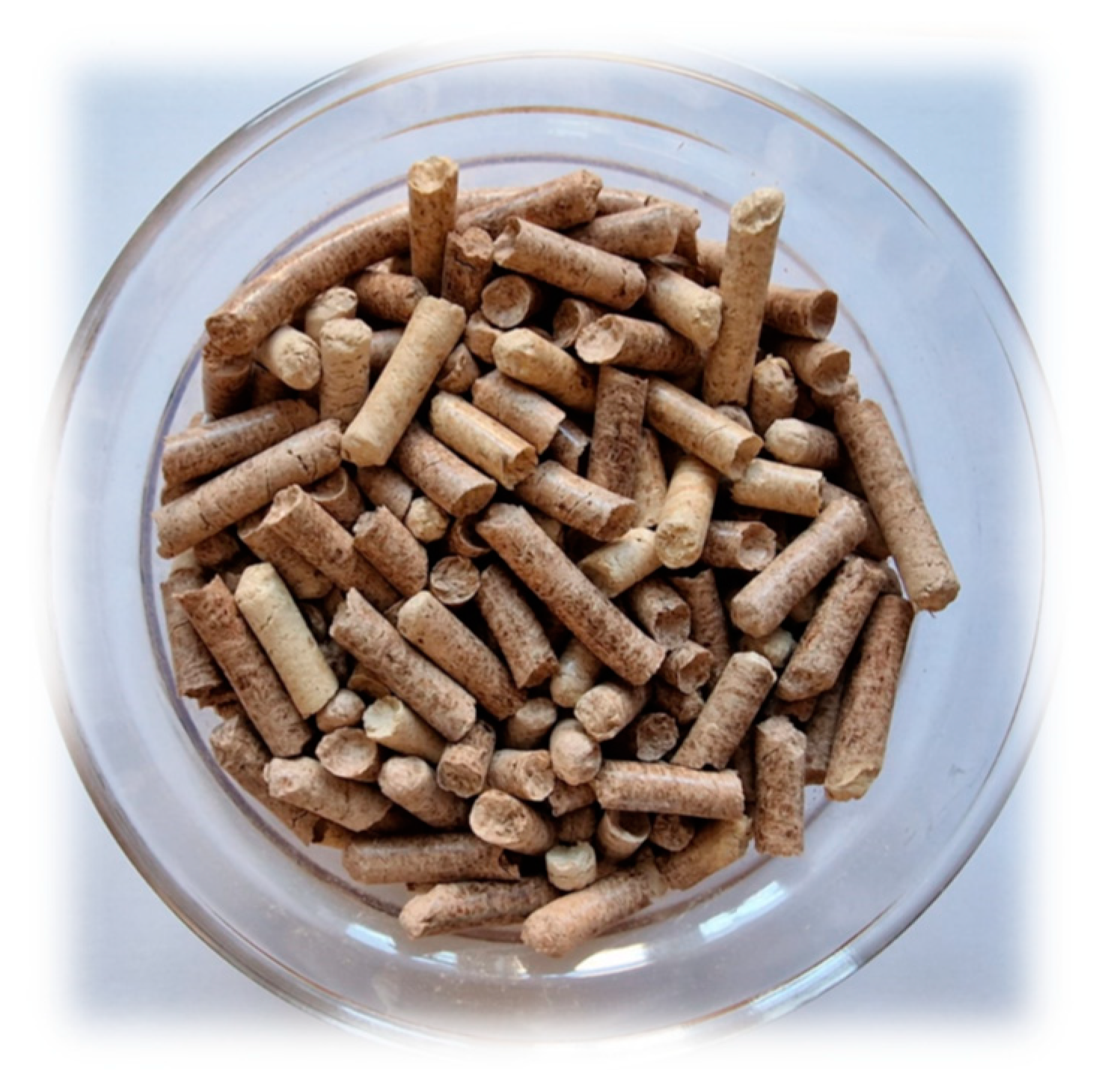
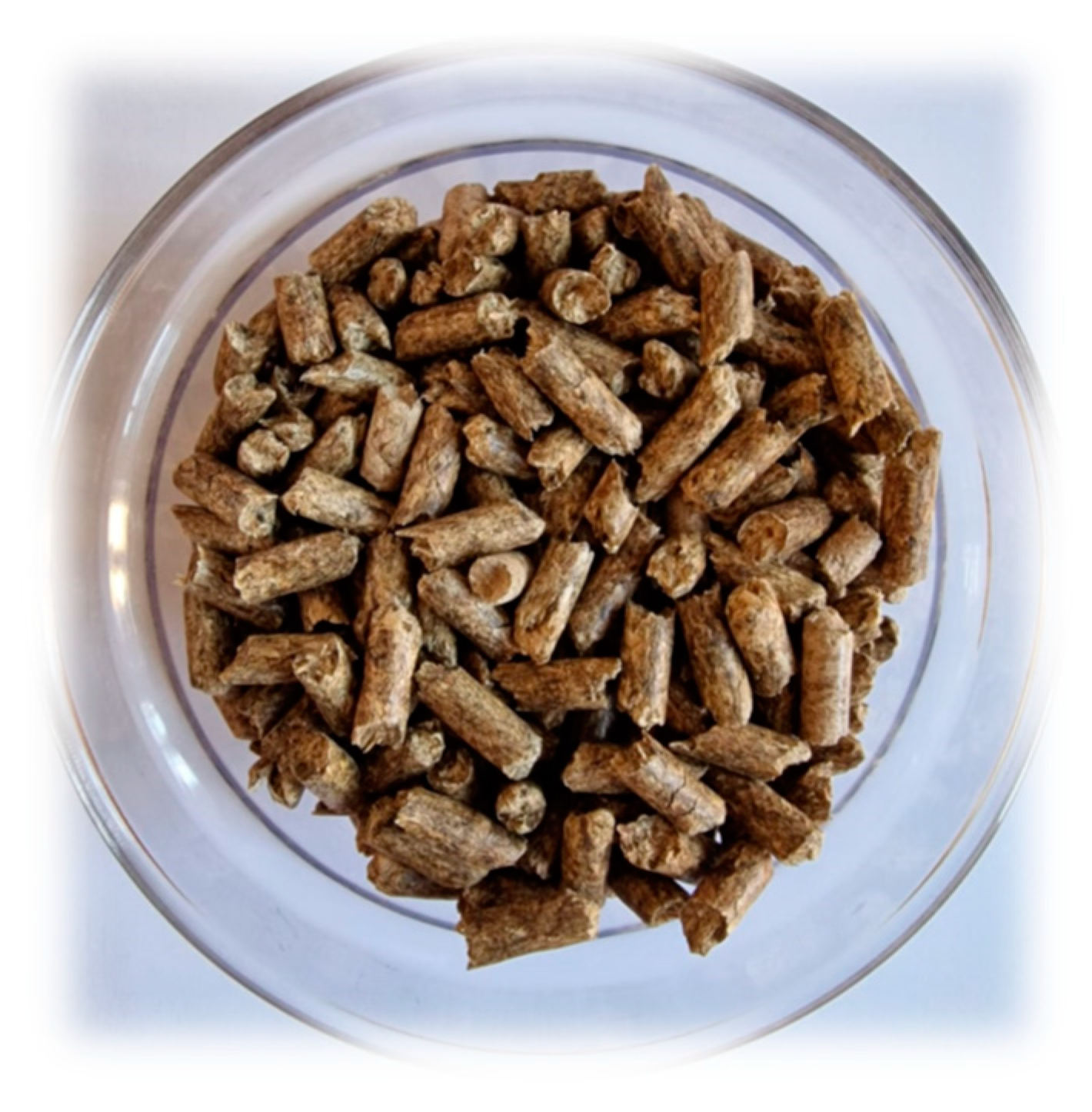
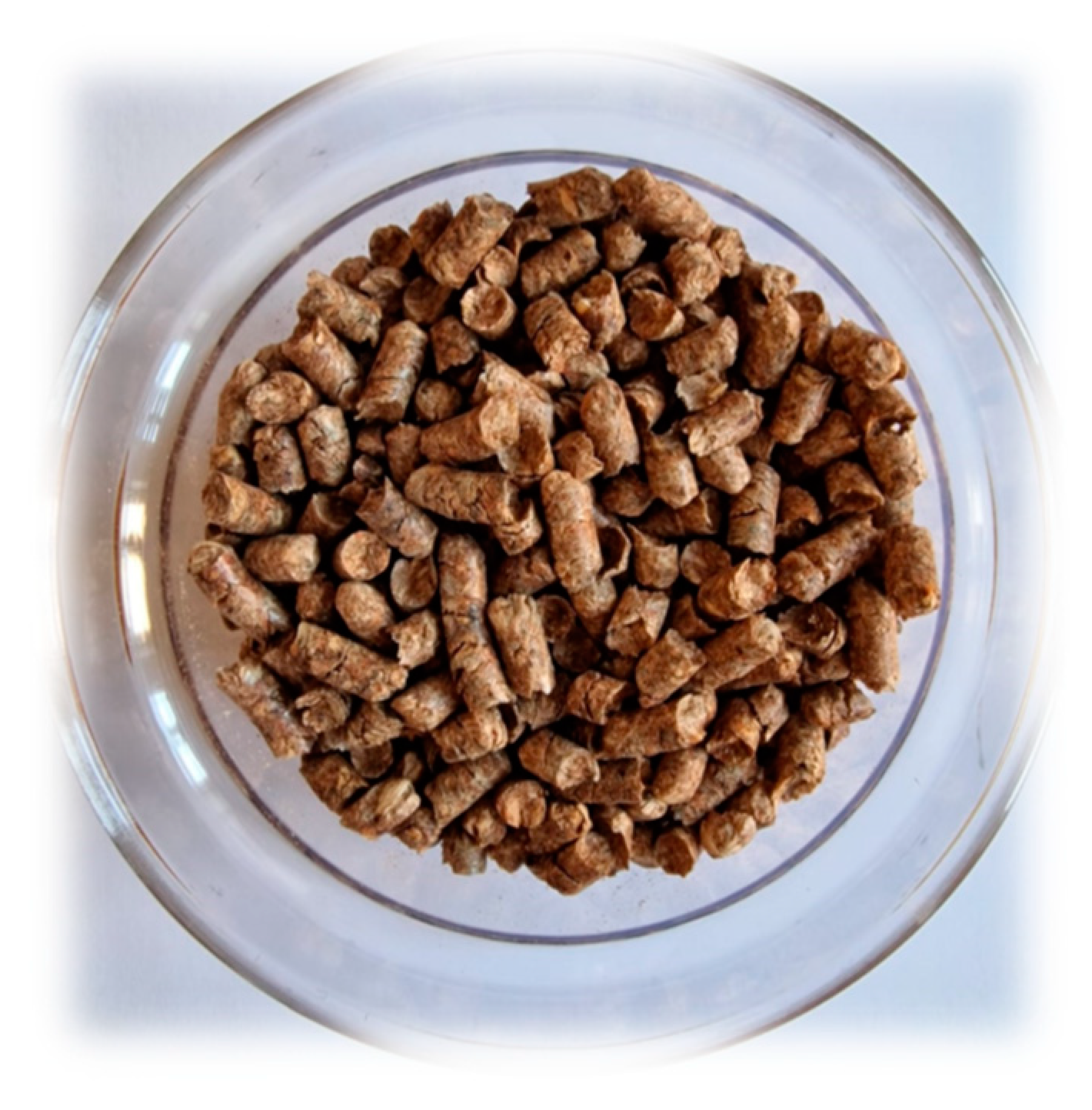
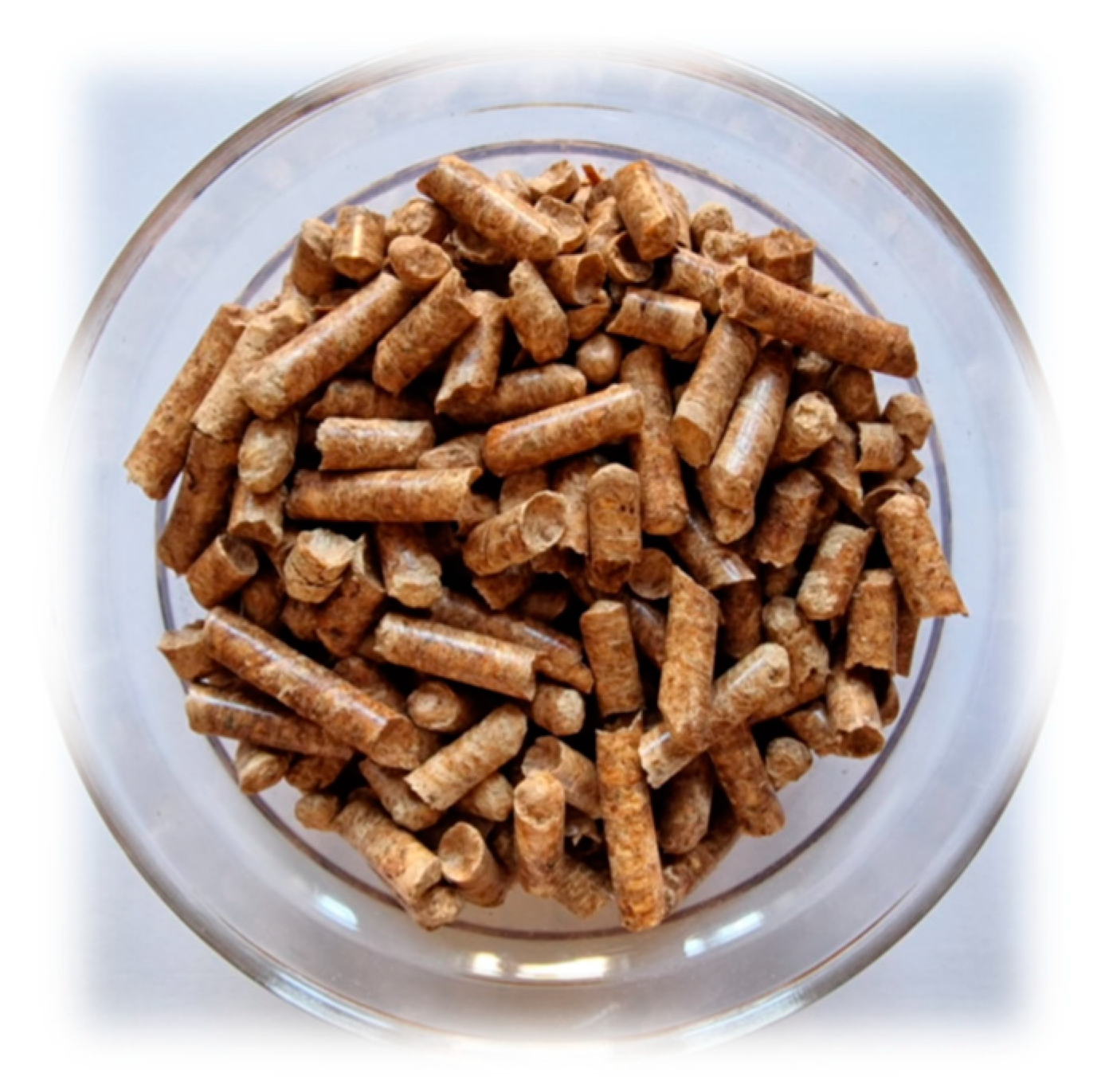
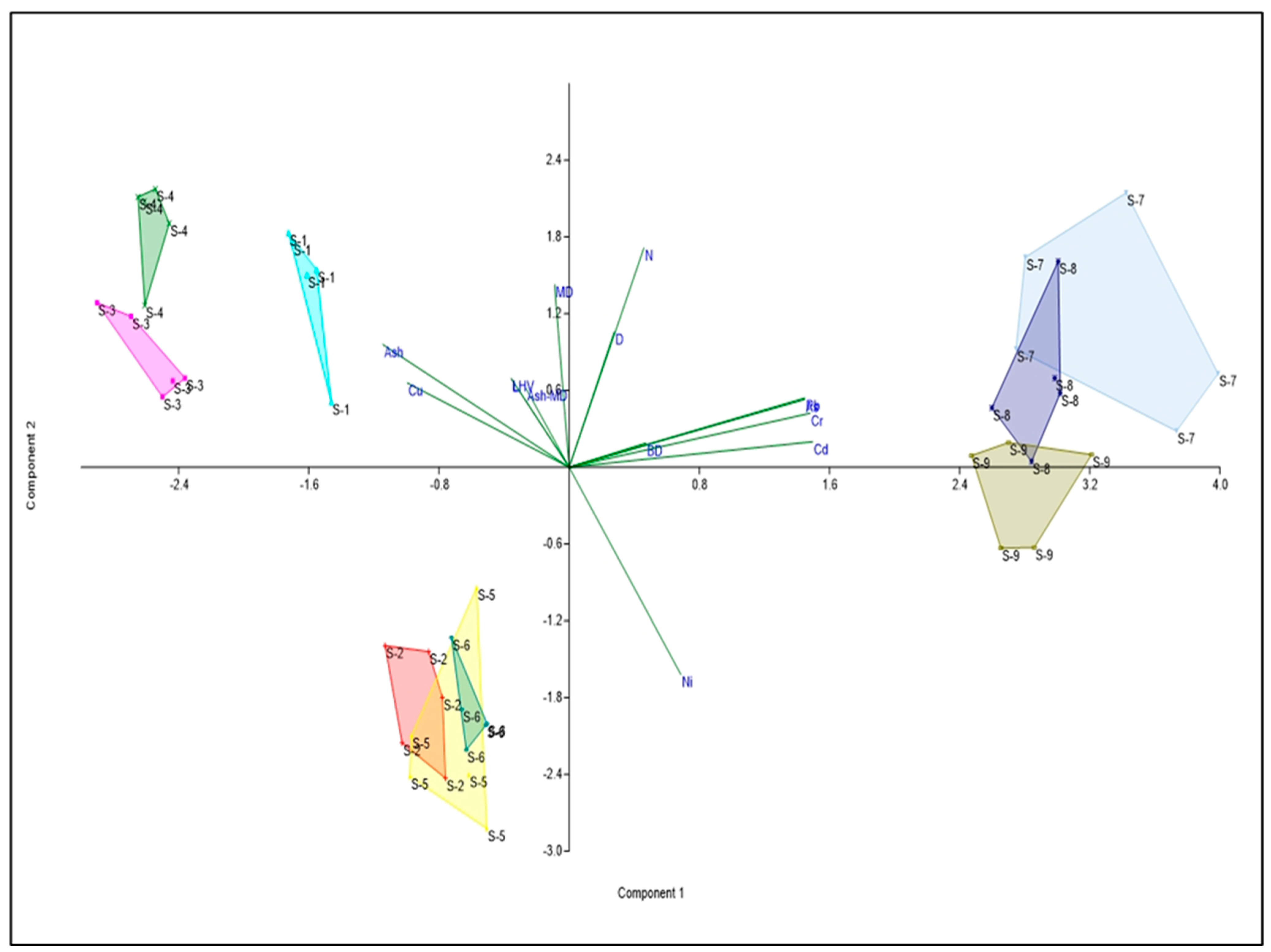
| Bulk Density (kg m−3) | Moisture Content (%) | ||
|---|---|---|---|
| MRF (6-year-old) | Poplar | 226.40 ± 10.61 | 10.05 ± 0.85 |
| Eucalypt | 278.11 ± 14.21 | 11.41 ± 1.10 | |
| Agricultural residues | Hazel tree | 252.82 ± 9.46 | 11.0 ± 0.74 |
| Olive tree | 220.47 ± 7.14 | 11.45 ± 0.56 | |
| Forest residues (18-year-old) | Radiata pine | 240.18 ± 2.73 | 12.09 ± 1.05 |
| Eucalypt | 289.16 ± 12.88 | 12.79 ± 1.41 | |
| Urban green residues | Holm oak | 368.75 ± 9.28 | 16.05 ± 1.12 |
| Eucalypt | 310.42 ± 20.21 | 15.45 ± 0.21 | |
| Italian Stone pine | 257.08 ± 3.33 | 15.08 ± 0.75 |
| Length (mm) | Diameter (mm) | Bulk Density (kg m−3) | Durability (%) | LHV (MJ kg−1) | Ash (%) | Fusibility (°C) | ||
|---|---|---|---|---|---|---|---|---|
| MRF | Poplar | 17.93 ± 5.3 f | 6.33 ± 0.2 d | 553.52 ± 6.0 bc | 98.56 ± 1.0 bc | 17.85 ± 0.1 e | 1.82 ± 0.2 d | 1404.60 ± 17.2 a |
| Eucalypt | 18.36 ± 5.7 f | 6.12 ± 0.1 ab | 611.43 ± 6.8 fg | 98.05 ± 0.5 bc | 14.43 ± 0.4 a | 1.52 ± 0.1 d | 1413.00 ± 31.1 ab | |
| Agricultural residues | Hazel tree | 10.44 ± 2.9 b | 6.20 ± 0.1 bc | 581.30 ± 3.1 de | 98.05 ± 0.5 c | 17.21 ± 0.3 d | 3.08 ± 0.6 e | 1448.60 ± 2.2 bc |
| Ulive tree | 16.64 ± 1.9 f | 6.20 ± 0.1 c | 562.38 ± 8.6 ce | 98.26 ± 0.6 c | 16.83 ± 0.1 cd | 2.57 ± 0.1 e | 1462.40 ± 1.8 c | |
| Forest residues | Radiata pine | 11.12 ± 3.8 b | 6.24 ± 0.2 c | 522.90 ± 26.4 a | 95.67 ± 0.7 a | 16.63 ± 0.2 cf | 0.85 ± 0.4 ac | 1439.00 ± 8.1 abc |
| Eucalypt | 9.16 ± 3.8 a | 6.10 ± 0.1 a | 605.19 ± 19.7 fd | 97.62 ± 0.5 bc | 15.52 ± 0.5 b | 1.52 ± 0.1 d | 1428.00 ± 33.8 abc | |
| Urban green residues | Holm oak | 12.72 ± 2.3 cd | 6.20 ± 0.1 c | 637.64 ± 1.6 g | 98.40 ± 0.7 c | 15.07 ± 0.1 b | 1.32 ± 0.2 bcd | 1434.74 ± 6.2 abc |
| Eucalypt | 14.67 ± 1.2 e | 6.24 ± 0.2 cd | 615.83 ± 11.4 fg | 98.15 ± 0.5 bc | 15.12 ± 0.6 ab | 0.87 ± 0.2 ac | 1429.36 ± 22.9 abc | |
| Italian Stone pine | 12.38 ± 1.9 c | 6.25 ± 0.1 cd | 532.41 ± 7.2 ab | 96.85 ± 0.7 ab | 18.27 ± 2.0 def | 0.38 ± 0.2 a | 1426.68 ± 9.6 abc |
| % | mg kg−1 | ||||||||
|---|---|---|---|---|---|---|---|---|---|
| N | As | Cd | Cr | Cu | Pb | Ni | Zn | ||
| MRF | Poplar | 1.45 ± 0.14 c | 0.005 ± 0.001 a | 0.195 ± 0.008 b | 0.156 ± 0.002 a | 0.831 ± 0.014 e | 0.032 ± 0.001 b | 0.202 ± 0.001 b | 12.587 ± 0.257 c |
| Eucalypt | 0.23 ± 0.05 a | 0.007 ± 0.001 b | 0.201 ± 0.004 b | 0.239 ± 0.006 d | 0.917 ± 0.050 d | 0.074 ± 0.006 c | 1.656 ± 0.021 e | 14.157 ± 0.473 d | |
| Agricultural residues | Hazel tree | 0.77 ± 0.21 ab | 0.021 ± 0.003 d | 0.021 ± 0.001 a | 0.211 ± 0.007 c | 6.104 ± 0.132 h | 0.213 ± 0.007 d | 1.214 ± 0.001 c | 4.512 ± 0.259 b |
| Olive tree | 1.24 ± 0.36 b | 0.051 ± 0.003 e | 0.000 ± 0.000 a | 0.186 ± 0.005 b | 2.933 ± 0.070 g | 0.000 ± 0.000 a | 0.064 ± 0.005 a | 4.878 ± 0.096 b | |
| Forest residues | Radiata pine | 0.59 ± 0.20 a | 0.009 ± 0.001 c | 0.202 ± 0.002 b | 0.252 ± 0.003 e | 0.945 ± 0.025 df | 0.074 ± 0.003 c | 1.701 ± 0.009 f | 14.434 ± 0.425 d |
| Eucalypt | 0.40 ± 0.20 a | 0.054 ± 0.003 e | 0.202 ± 0.005 b | 0.247 ± 0.008 de | 0.944 ± 0.021 df | 0.076 ± 0.003 c | 1.683 ± 0.011 e | 14.684 ± 0.271 d | |
| Urban green residues | Holm oak | 1.58 ± 0.48 c | 0.715 ± 0.146 f | 0.844 ± 0.115 d | 1.002 ± 0.162 f | 0.479 ± 0.047 c | 1.458 ± 0.213 f | 1.539 ± 0.211 def | 1.495 ± 0.231 a |
| Eucalypt | 1.54 ± 0.50 c | 0.794 ± 0.071 f | 0.660 ± 0.054 c | 0.907 ± 0.027 f | 0.369 ± 0.016 b | 1.294 ± 0.051 f | 1.326 ± 0.051 d | 1.320 ± 0.037 a | |
| Italian stone pine | 0.72 ± 0.17 ab | 0.788 ± 0.054 f | 0.860 ± 0.141 d | 0.884 ± 0.018 f | 0.342 ± 0.014 a | 1.228 ± 0.014 e | 1.317 ± 0.031 d | 1.302 ± 0.011 a | |
| MRF | Agricultural Residues | Forest Residues | Urban Green Residues | ||||||
|---|---|---|---|---|---|---|---|---|---|
| Poplar | Eucalypt | Hazel | Olive | Radiata Pine | Eucalypt | Holm Oak | Eucalypt | Italian Stone Pine | |
| Length | ✓ | ✓ | ✓ | ✓ | ✓ | ✓ | ✓ | ✓ | ✓ |
| Diameter | ✓ | ✓ | ✓ | ✓ | ✓ | ✓ | ✓ | ✓ | ✓ |
| Bulk density | X | ✓ | X | X | X | ✓ | ✓ | ✓ | X |
| Durability | A1 | A1 | A1 | A1 | X | A2 | A1 | A1 | X |
| LHV | ✓ | X | ✓ | ✓ | ✓ | X | X | X | ✓ |
| Ash | B | B | X | X | A2 | B | B | A2 | A1 |
| Fusibility | ✓ | ✓ | ✓ | ✓ | ✓ | ✓ | ✓ | ✓ | ✓ |
| N | X | A1 | B | X | B | A2 | X | X | B |
| As | ✓ | ✓ | ✓ | ✓ | ✓ | ✓ | ✓ | ✓ | ✓ |
| Cd | ✓ | ✓ | ✓ | ✓ | ✓ | ✓ | X | X | X |
| Cr | ✓ | ✓ | ✓ | ✓ | ✓ | ✓ | ✓ | ✓ | ✓ |
| Cu | ✓ | ✓ | ✓ | ✓ | ✓ | ✓ | ✓ | ✓ | ✓ |
| Pb | ✓ | ✓ | ✓ | ✓ | ✓ | ✓ | ✓ | ✓ | ✓ |
| Ni | ✓ | ✓ | ✓ | ✓ | ✓ | ✓ | ✓ | ✓ | ✓ |
| Zn | ✓ | ✓ | ✓ | ✓ | ✓ | ✓ | ✓ | ✓ | ✓ |
Disclaimer/Publisher’s Note: The statements, opinions and data contained in all publications are solely those of the individual author(s) and contributor(s) and not of MDPI and/or the editor(s). MDPI and/or the editor(s) disclaim responsibility for any injury to people or property resulting from any ideas, methods, instructions or products referred to in the content. |
© 2023 by the authors. Licensee MDPI, Basel, Switzerland. This article is an open access article distributed under the terms and conditions of the Creative Commons Attribution (CC BY) license (https://creativecommons.org/licenses/by/4.0/).
Share and Cite
Civitarese, V.; Acampora, A.; Sperandio, G.; Bassotti, B.; Latterini, F.; Picchio, R. A Comparison of the Qualitative Characteristics of Pellets Made from Different Types of Raw Materials. Forests 2023, 14, 2025. https://doi.org/10.3390/f14102025
Civitarese V, Acampora A, Sperandio G, Bassotti B, Latterini F, Picchio R. A Comparison of the Qualitative Characteristics of Pellets Made from Different Types of Raw Materials. Forests. 2023; 14(10):2025. https://doi.org/10.3390/f14102025
Chicago/Turabian StyleCivitarese, Vincenzo, Andrea Acampora, Giulio Sperandio, Beatrice Bassotti, Francesco Latterini, and Rodolfo Picchio. 2023. "A Comparison of the Qualitative Characteristics of Pellets Made from Different Types of Raw Materials" Forests 14, no. 10: 2025. https://doi.org/10.3390/f14102025







